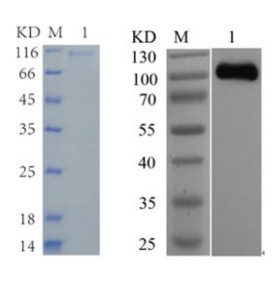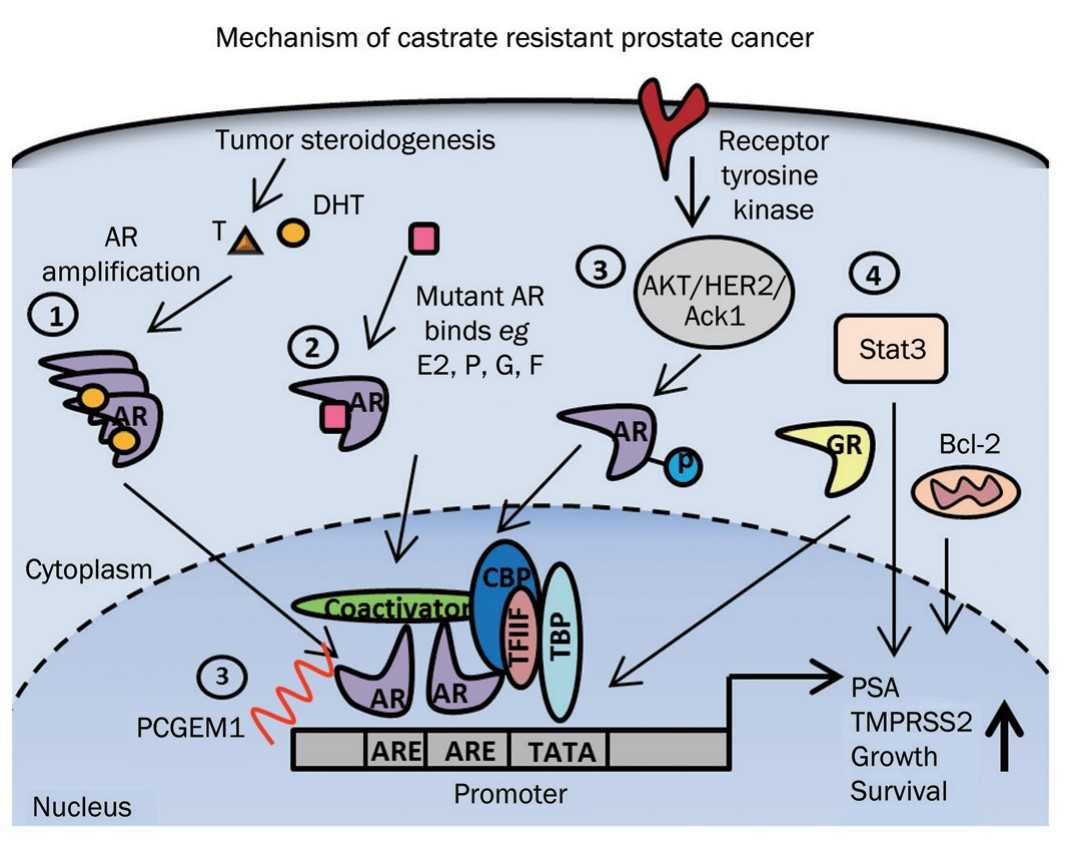Recombinant Human Androgen Receptor protein
| Cat.No. : | AR-001H |
| Product Overview : | Recombinant Human Androgen Receptor protein was expressed in Insect cell. |
| Availability | April 20, 2025 |
| Unit | |
| Price | |
| Qty |
- Specification
- Gene Information
- Related Products
- Case Study
- Application
- Download
| Species : | Human |
| Source : | Insect Cells |
| Protein Length : | 1-920 aa |
| Description : | The androgen receptor gene is more than 90 kb long and codes for a protein that has 3 major functional domains: the N-terminal domain, DNA-binding domain, and androgen-binding domain. The protein functions as a steroid-hormone activated transcription factor. Upon binding the hormone ligand, the receptor dissociates from accessory proteins, translocates into the nucleus, dimerizes, and then stimulates transcription of androgen responsive genes. This gene contains 2 polymorphic trinucleotide repeat segments that encode polyglutamine and polyglycine tracts in the N-terminal transactivation domain of its protein. Expansion of the polyglutamine tract from the normal 9-34 repeats to the pathogenic 38-62 repeats causes spinal bulbar muscular atrophy (SBMA, also known as Kennedy's disease). Mutations in this gene are also associated with complete androgen insensitivity (CAIS). Alternative splicing results in multiple transcript variants encoding different isoforms. |
| Form : | PBS buffer, pH 7.4. |
| Molecular Mass : | ~ 101 kDa |
| AA Sequence : | HHHHHHMEVQLGLGRVYPRPPSKTYRGAFQNLFQSVREVIQNPGPRHPEAASAAPPGASLLLLQQQQQQQQQQQQQQQQQQQQQQQETSPRQQQQQQGEDGSPQAHRRGPTGYLVLDEEQQPSQPQSALECHPERGCVPEPGAAVAASKGLPQQLPAPPDEDDSAAPSTLSLLGPTFPGLSSCSADLKDILSEASTMQLLQQQQQEAVSEGSSSGRAREASGAPTSSKDNYLGGTSTISDNAKELCKAVSVSMGLGVEALEHLSPGEQLRGDCMYAPLLGVPPAVRPTPCAPLAECKGSLLDDSAGKSTEDTAEYSPFKGGYTKGLEGESLGCSGSAAAGSSGTLELPSTLSLYKSGALDEAAAYQSRDYYNFPLALAGPPPPPPPPHPHARIKLENPLDYGSAWAAAAAQCRYGDLASLHGAGAAGPGSGSPSAAASSSWHTLFTAEEGQLYGPCGGGGGGGGGGGGGGGGGGGGGGGEAGAVAPYGYTRPPQGLAGQESDFTAPDVWYPGGMVSRVPYPSPTCVKSEMGPWMDSYSGPYGDMRLETARDHVLPIDYYFPPQKTCLICGDEASGCHYGALTCGSCKVFFKRAAEGKQKYLCASRNDCTIDKFRRKNCPSCRLRKCYEAGMTLGARKLKKLGNLKLQEEGEASSTTSPTEETTQKLTVSHIEGYECQPIFLNVLEAIEPGVVCAGHDNNQPDSFAALLSSLNELGERQLVHVVKWAKALPGFRNLHVDDQMAVIQYSWMGLMVFAMGWRSFTNVNSRMLYFAPDLVFNEYRMHKSRMYSQCVRMRHLSQEFGWLQITPQEFLCMKALLLFSIIPVDGLKNQKFFDELRMNYIKELDRIIACKRKNPTSCSRRFYQLTKLLDSVQPIARELHQFTFDLLIKSHMVSVDFPEMMAEIISVQVPKILSGKVKPIYFHTQ YPYDVPDYA |
| Purity : | >85 % |
| Storage : | Long Term Storage at -20 centigrade to -80 centigrade. Avoid freeze/thaw cycles. |
| Concentration : | 0.15 ug/ul |
| Publications : |
(+)-JJ-74–138 is a Novel Noncompetitive Androgen Receptor Antagonist (2022)
|
| Gene Name | AR androgen receptor [ Homo sapiens (human) ] |
| Official Symbol | AR |
| Synonyms | KD; AIS; AR8; TFM; DHTR; SBMA; HYSP1; NR3C4; SMAX1; HUMARA |
| Gene ID | 367 |
| mRNA Refseq | NM_000044 |
| Protein Refseq | NP_000035 |
| MIM | 313700 |
| UniProt ID | P21730 |
| ◆ Cell & Tissue Lysates | ||
| AR-8764HCL | Recombinant Human AR 293 Cell Lysate | +Inquiry |
Case 1: Cole RN, et al. Mol Cancer Ther. 2022
Clinically approved AR antagonists compete with dihydrotestosterone (DHT) for binding to the ligand-binding domain (LBD) of AR, and patients eventually develop resistance to these treatments. One approach to overcoming resistance is to discover compounds that inhibit AR in alternative ways. In this study, the researchers identified a small molecule, JJ-450 and they also developed structural analogues of JJ-450 and identified (+)-JJ-74-138 as a promising candidate.
Here, To test the potential direct binding and the kinetic binding parameters of (+)-JJ-74-138 to AR, full length recombinant AR was purified using a baculovirus system, and binding was measured using surface plasmon resonance (SPR). (+)-JJ-74-138 exhibited a KD of 4.29 μM, indicating that (+)-JJ-74-138 could bind directly to the AR.
The observations suggest that (+)-JJ-74-138 is a novel noncompetitive AR antagonist capable of inhibiting enzalutamide-resistant CRPC.

Fig1. SDS-PAGE and Western Blot of purified full-length AR.

Fig2. Verage collimated light reflectivity variations and calculated KD for injections of (+)-JJ-74-138, tamoxifen, or enzalutamide.
Case 2: Zhang F, et al. Nucleic Acids Res. 2023
The androgen receptor (AR), the main oncogenic driver in prostate cancer (PCa), contains large disordered regions and is co-recruited with the transcriptional coactivator mediator complex subunit 1 (MED1) to SEs in androgen-dependent PCa cells, thereby promoting oncogenic transcriptional programs. In this work, the researchers reveal that full-length AR forms foci with liquid-like properties in different PCa models.
AR ability to phase separate was also validated in vitro by using recombinant full-length AR protein with In vitro droplet assay and FRAP assay.
The results suggest that enhanced compartmentalization of AR and coactivators may play an important role in the activation of oncogenic transcription programs in androgen-dependent PCa.

Fig1. Effect of PEG-8000 concentration on His-AR-mEGFP (0.25 μM) droplet formation.

Fig2. FRAP assay showing fluorescence recovery after photobleaching.
One of the main applications of rhAR protein is in research and drug development. Scientists use rhAR protein to study the androgen receptor's structure and function in order to better understand its role in diseases such as prostate cancer. This knowledge can then be used to develop new drugs targeting the androgen receptor.
Another potential application of rhAR protein is in the development of diagnostic tests for diseases that are affected by the androgen receptor, such as prostate cancer. By detecting levels of rhAR protein in a patient's blood or tissue samples, doctors can diagnose and monitor the progression of these diseases more accurately.
Additionally, rhAR protein may also have potential therapeutic applications. Drugs targeting the androgen receptor could potentially be used to treat diseases such as prostate cancer and other androgen-related disorders. By studying the structure and function of the androgen receptor using rhAR protein, scientists can identify potential drug targets and develop more effective treatments.
Overall, the applications of rhAR protein are diverse and far-reaching, with potential implications for both research and clinical practice in the fields of oncology, endocrinology, and drug development.

Fig1. Androgen and AR action in castration-resistant prostate cancer. (M H Eileen Tan, 2015)
Not For Human Consumption!
Inquiry
- Reviews
- Q&As
Ask a Question for All AR Products
Required fields are marked with *
My Review for All AR Products
Required fields are marked with *
Inquiry Basket


